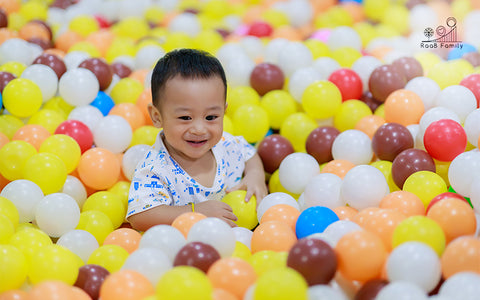Many of us grew up with parents who viewed playtime as impractical and never allowed us to have fun. But contrary to this age-old belief, these sessions of fun and games actually play key roles in child development. If you’re in the pursuit of fostering a nurturing environment where your child can learn and grow, we recommend creating an indoor playground for them! From building interactive zones to ensuring safety while promoting independence, we’ve put together a guide to help you design the best space for your child. Keep reading to learn all the tips and tricks!
1.1. Importance of Play in a Baby’s Development
You may be wondering, “how is playtime going to help my child excel in the future?” Well, these moments of amusement can make little changes in your child’s body to facilitate growth and development for healthier adult years. In fact, studies have shown that play deprivation can have detrimental effects on children, and may increase their risk of major emotional dysregulation. Unconvinced? Here’s how your child develops when they play:
-
Cognitive Development
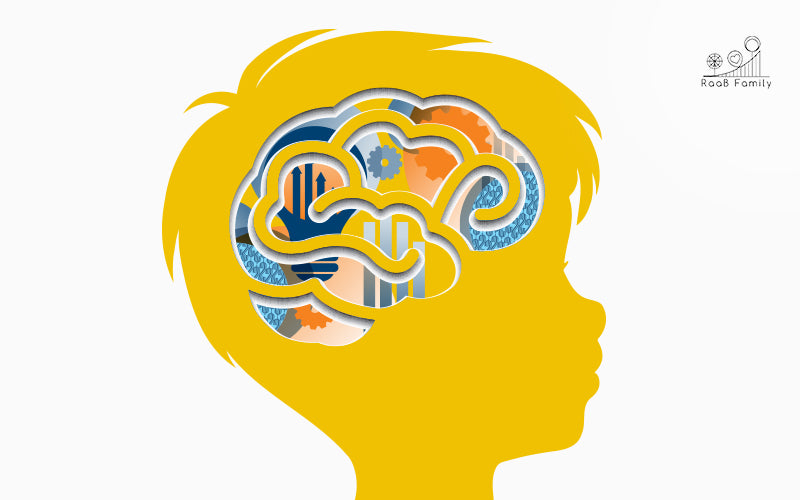
Your child’s senses are constantly being stimulated when they play. Whether it’s the sense of touch when they hold their toys, the vibrant colours they see, or the noise that’s produced when objects hit each other, when their five senses are activated, their brains create and strengthen neural connections that will be helpful for enhancing cognitive function. These sensory experiences also help to develop their senses, which will enhance their ability to understand and navigate the world around them.
-
Emotional Development
Playtime is also an opportunity for children to connect with and make sense of their own feelings. Whether it’s laughing when something amuses them or crying when things don’t go their way, these moments expose them to different emotions while offering a natural outlet for expression. Little achievements and positive interactions with you or their playmates during play also builds self-esteem and confidence. All these effects add up to create a solid emotional foundation that will shape how they deal with challenges growing up.
-
Social Development

Play is also a social activity that cultivates a child’s ability to interact healthily with the people around them, especially if they’re playing in a group. Engaging in simple games or playing with toys together refines their social and communication abilities, as well as teaches children about sharing and taking turns. As they learn to understand the dynamics of relationships, they’re also setting the stage for healthy social interactions throughout their lives.
-
Physical Development
Designing an Indoor Baby Playground
2.1. The Benefits of a Dedicated Play Space
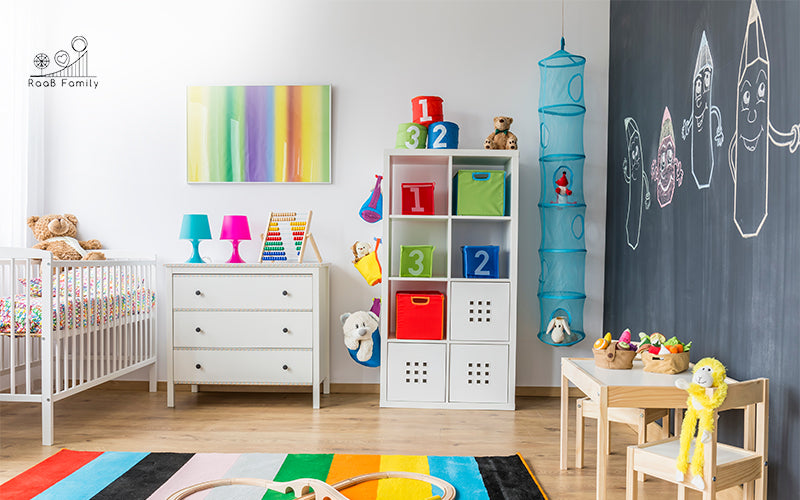
By a dedicated play space, we mean allocating a part of your home just for your child’s play. If you’re wondering why your child can’t just play anywhere? The truth is, while you think that your home is extremely safe, it may possess safety hazards that can be dangerous to your child. Building an exclusive play zone for them and limiting their movement to within the boundaries you set gives them a secure environment where they are free to explore and grow. This also brings forth a myriad of benefits.
-
Instil a Sense of Routine and Security
Children favour routine, and providing them with this predictability and stability through a dedicated play space can instil a sense of security that will aid in promoting greater emotional well-being.
-
Promote Sensory Stimulation
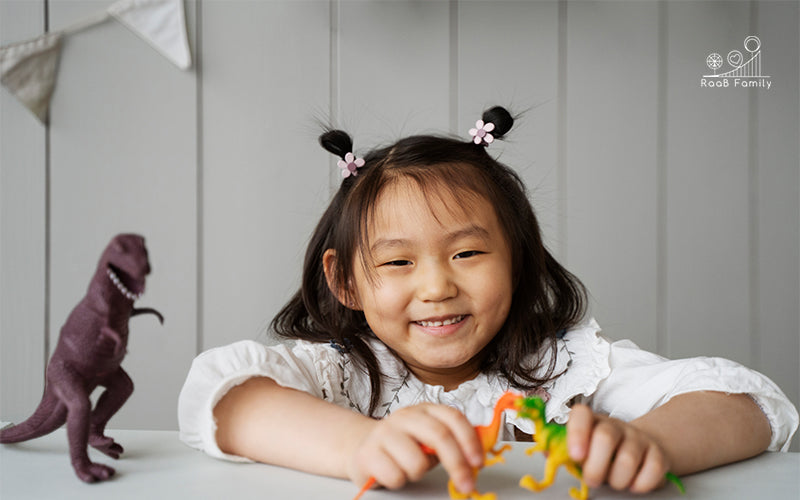
In a space designed specifically for play, you can incorporate various sensory stimuli that will work to engage your child’s five senses and enhance their sensory processing skills. Whether it’s through colourful toys, textured surfaces, or interactive toys, this exposure contributes to improved cognitive abilities and a more robust foundation for future learning.
-
Encourage Independence
Keeping your child within a safe and dedicated environment for play grants them the autonomy to make their own choices, experiment with their surroundings, and engage in activities themselves. Fostering independence this way helps them build confidence, develop problem-solving skills, and even a positive self-image, which are crucial for emotional and social growth.
-
Facilitate Free Movement and Develop Motor Skills
Within this dedicated play space, your child will also get the chance to move freely and explore their physical limitations. Such unrestricted movement is essential for the development of motor skills, coordination, and muscle strength.
-
Keep Play and Sleep Areas Separate
Establishing a zone just for play helps create a clear distinction between areas designated for fun and those intended for sleep, which will do wonders for your child’s sleep quality at night. They’ll learn to associate the baby nursery with sleep, and will be more likely to fall asleep faster when placed in their crib. However, if you combine their play and sleep areas, the chances of them wanting to play while in their bedroom increases and may prevent them from getting a good night’s rest.
Learn More: 6 Strategies to Help Your Baby Sleep Through the Night
2.2. Step-by-Step Guide to Designing the Indoor Playground
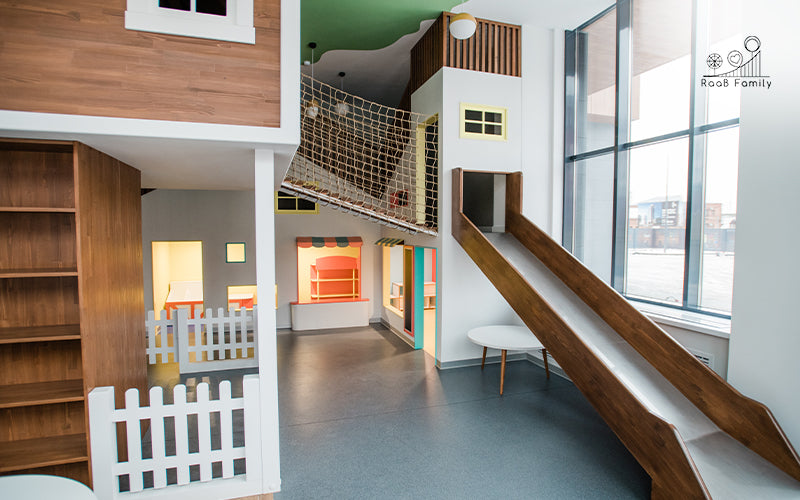
Now that you’re aware of the benefits a dedicated indoor playground can provide to your child. Let’s get started on building that fun and nurturing environment for them.
Step 1: Define Purpose and Age Group
Children grow very quickly and have different developmental needs depending on their age group. Understanding these details is crucial to designing a space that suits them best. If your child falls between the ages of two and four, they’ll need an environment filled with soft surfaces and simple structures to enhance motor skills safely. But if your child is much older, you can consider incorporating more complex toys to stimulate cognitive development and even an indoor slide for kids to promote activity, strengthening their muscles and fitness.
Step 2: Establish Your Budget
Once you know what you need to add to your child’s play area, you’ll need to establish your budget. Nobody wants to design a space at the expense of their own pocket. So, consider construction costs, equipment expenses, safety features and possible future maintenance needed. A well-thought-out budget will help ensure that the playground doesn’t just meet your child’s needs, but also remains sustainable for you in the long run.
Step 3: Choose a Suitable Area
Now that you have the basics nailed down, it’s time to find a spot within your home to build this indoor playground. This is a crucial decision as it’ll determine the success of this space. You want to identify a zone that meets all safety requirements, offers enough room for movement, and has proper ventilation and lighting. But that’s not all. You’ll also have to consider its proximity to bathrooms, whether it’s easily accessible for you, and if you can secure the area to prevent unauthorised access.
Step 4: Create a Layout and Floor Plan
Settled on a location? Based on the layout of the space, you’ll now need to create a floor plan that maximises land use. Think about the flow of movement, where you’ll place entrances and exits, and the position of seating areas for adults. Allocate areas for each activity and use, ensuring that there’s ample space for your child to move around and explore safely. During this stage, you should also note down the furniture and toys you’ll need to purchase.
Step 5: Choose a Cohesive Theme and Decor
Lastly, decide on a cohesive theme to decorate the space in. Whether it’s a castle, an undersea exploration, or futuristic space station, putting in the extra effort to design a visually-appealing environment will pay off in the future. Not only does it stimulate your child’s senses and imagination, it’ll also work to enhance their overall experience, which can contribute to their growth even in their adult years.
Essential Elements for a Stimulating Indoor Playground
Not sure how to go about furnishing a child’s indoor play area to make it stimulating and nurturing? Here are some elements to consider:
-
Sensory Bins
Filling bins or baskets with a variety of textured items like kinetic sand, soft fabrics, rice, or water beads and using them for play is a fantastic way to engage your child’s senses. The tactile experience promotes the development of fine motor skills and sensory exploration, which is helpful for improving cognitive abilities. Do make sure that you’re using items safe for children and not those that will pose choking hazards.
-
Imaginative Play Zones
Does your child enjoy role-playing? Whether it’s through simulating a cooking demonstration or playing doctor, you’ll want to design a space that encourages pretend play. Such activities are actually great for sparking their imagination, fostering creativity, developing social and problem-solving skills, and even their linguistic capabilities.
-
Building Blocks and Construction Toys
Building blocks and construction toys have always been the go-to play items for generations. And this isn’t without reason. Playing with them promotes spatial awareness, hand-eye coordination, and problem-solving skills, and allows children to discover new ways to play. Needless to say, they can help to enhance cognitive abilities and contribute greatly to numerous aspects of a child’s development.
-
Art & Crafts Corner
Arts and Crafts projects give children the opportunity to express their creativity through art. Through drawing, painting, colouring, cutting, and other activities, they also develop their fine motor skills and hand-eye coordination. If you’re keen to help your child grow in these aspects, equip a corner of their play area with a variety of art materials such as paper, crayons, markers, glue, and child-friendly scissors.
-
Interactive Wall Features
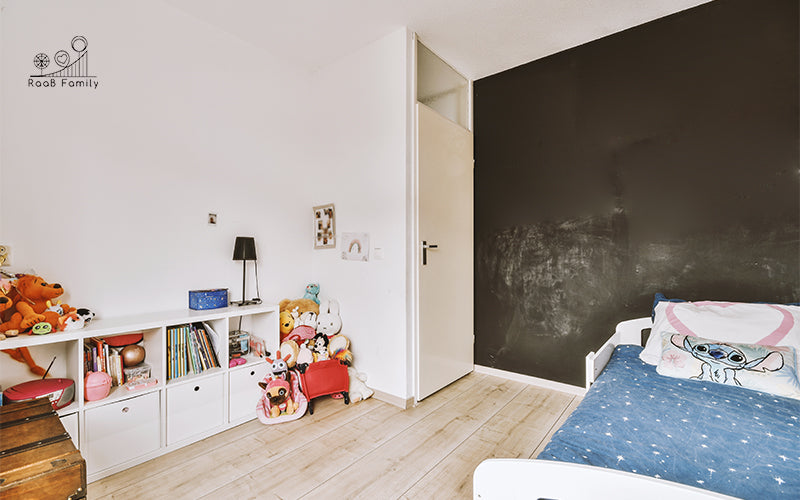
-
Brightly-Coloured Spaces
Bright colours are capable of capturing a child’s attention and activating various sensory responses in their brain. So, consider filling your child’s play area with vibrant and contrasting shades, such as colourful thick playmats or wallpapers, to create an energetic and visually-stimulating environment that works to improve cognitive function.
However, this will only work for children above six months old. If they’re too young, we recommend keeping colours to a minimum and use alternating hues (e.g. white and black) to support their development of visual perception.
Learn More: Why the Colours You Choose for Your Baby’s Environment Matters
2.3. Safety Considerations and Childproofing Tips
While an indoor play area is crucial for your child’s development, safety should never be overlooked. In this section, we’ll share some tips for designing an environment that’s both fun and safe for your little ones.
-
Anchor Heavy Furniture and Appliances
Don’t want heavy furnishings toppling over and seriously injuring your family? Mitigate this danger by anchoring them securely to your wall or floor.
-
Cover Sharp Edges
Children are very active and may bump into corners as they run about. To prevent bumps, bruises, cuts, or more severe injuries, cover all the sharp edges with corner guards or cushioned edge protectors.
-
Secure Electrical Elements
Curiosity kills the cat, and the little snoopy hands may get into lots of trouble if you leave cords and wires dangling around. Reduce the risk of strangulation, tripping, or electrocution by securing all loose wires, and use outlet covers to prevent your child from touching electrical points.
-
Opt for Safe Flooring
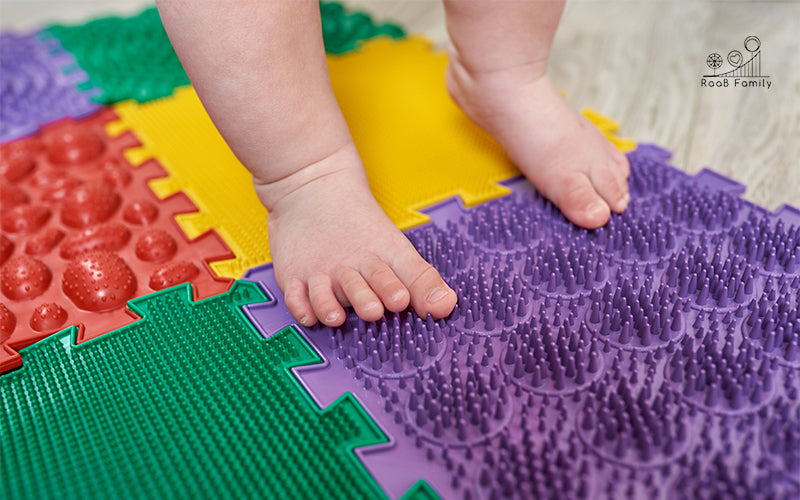
Soft, padded materials or interlocking baby playmats are great for absorbing impact and lowering the risk of severe injuries during playtime. Choose to invest in non-slip playmats to prevent slips and falls during active play.
-
Use Baby Safety Gates
Containing your child within a safe boundary is key to keep them from wandering into potentially dangerous zones in your home, such as your kitchen. And baby safety gates or foldable play yards are great solutions you can tap on. By limiting your little one to a restricted area, you’re not only stopping them from coming into contact with hazardous elements, but also encouraging independent play. You’ll get to enjoy peace of mind as you turn your attention to other tasks knowing that they won’t venture into other areas.
-
Choose Age-Appropriate Toys
Toys with small parts can pose a choking hazard to infants, and kindergarten-going children will no longer appreciate the shaker toys they used to play as babies. When buying these things for your child’s indoor play area, always consider their appropriateness and if they’ll do any good to your child. Additionally, regularly inspect toys for wear and tear, discarding any damaged items promptly. This vigilance about toy safety will ensure a risk-free play environment.
-
Maintain Comfortable Room Temperature
Children under the age of 18 are typically more vulnerable to temperature changes, especially when it gets too hot. Hence, it’s important to maintain a comfortable room temperature in their play area by installing a few fans or switching on the air conditioning. Alternatively, dress your little one appropriately, such as in lightweight fabrics, to ensure their comfort and well-being during playtime.
-
Choose Sturdy Furniture
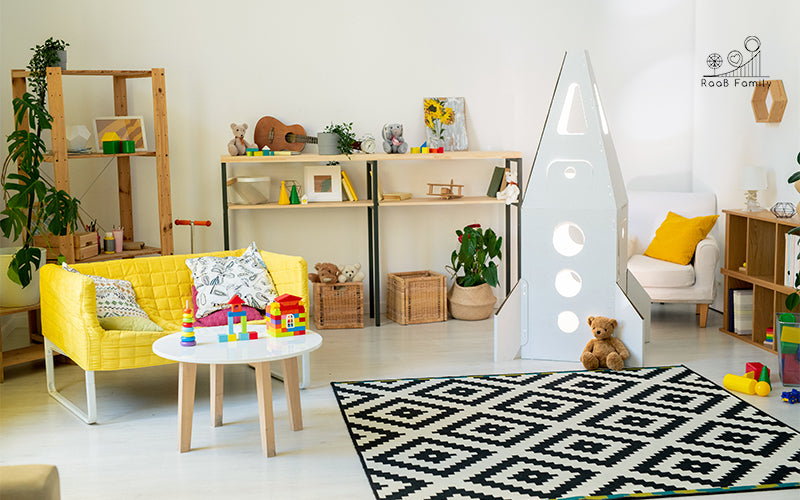
Lastly, invest in well-built and sturdy furniture that can withstand the demands of active play. Also, periodically check for any signs of damage or instability to minimise the risk of accidents caused by faulty items.
Tips for Choosing Safe Baby Furniture
- Look for certifications, such as the European Union safety standards (CE marking) and the Consumer Protection (Consumer Goods Safety Requirements) Regulations.
- Check whether the baby furniture is constructed with high-quality materials like solid wood or metal, and avoid those with flimsy components or weak joints that may pose a risk of collapsing.
- Choose baby essentials that are free from harmful chemicals, lead, and other toxic substances. We recommend opting for those coated with water-based or organic finishes, as they are less likely to emit harmful fumes.
- Steer clear of furniture with sharp edges or corners that could potentially cause injuries.
- Look for items equipped with baby safety features, such as drawer stops, which prevent drawers from being pulled out completely.
- Ensure that the furniture is stable and unlikely to tip over.
- Choose furniture that is easy to assemble and disassemble, preferably without the use of small and loose parts.
- Before making a purchase, read reviews from other parents who have used the same baby furniture. Personal experiences and recommendations can provide valuable insights into the safety, durability, and functionality of the products.
Encouraging Active Play
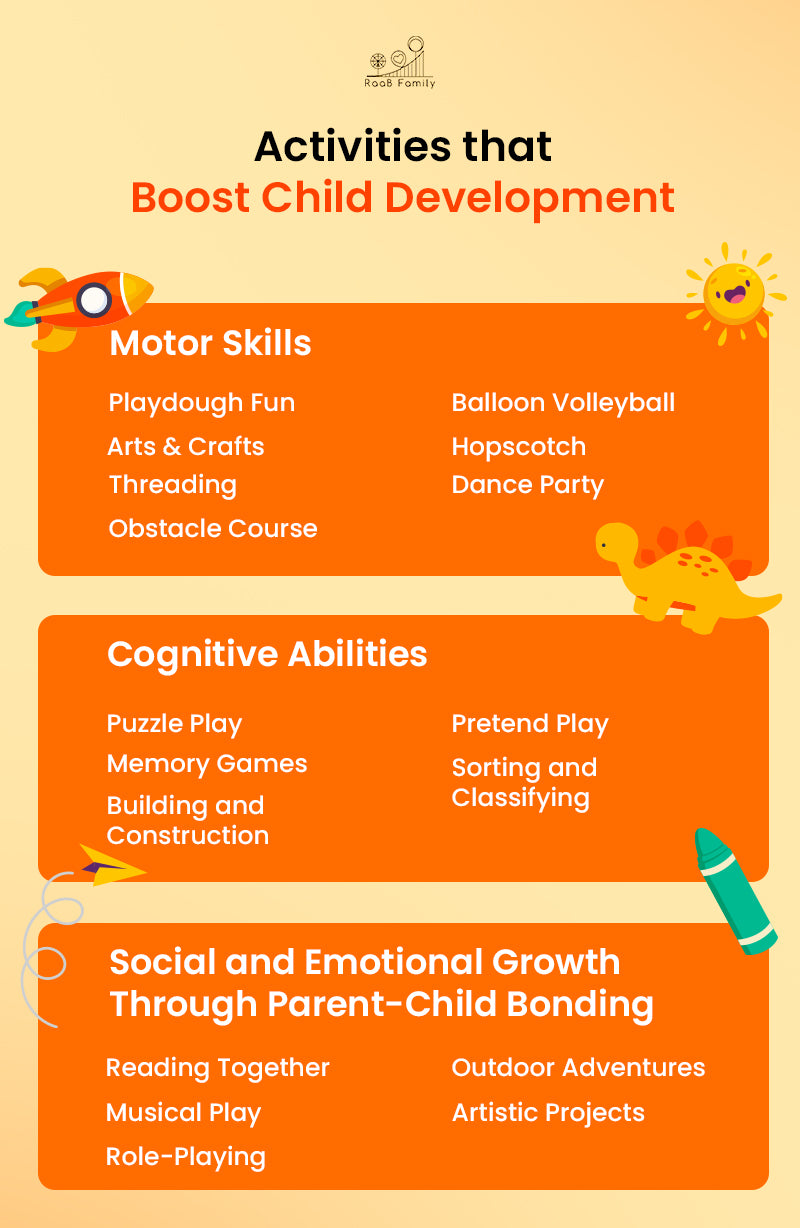
Want to enhance your child’s growth but not quite sure how you can go about doing it? We share some activities that you can engage in with your child to help boost their development.
3.1. Activities that Boost Motor Skills
-
Playdough Fun
Squeezing, rolling, and shaping playdough engage your child’s hands in a range of motions that are helpful in strengthening muscles, improving grip strength, and enhancing fine motor control.
-
Cutting and Pasting
Cutting and pasting requires your child to practise precise movements, which can refine their hand control and coordination.
-
Threading Activities
Threading large beads, pasta, or cereal with holes onto string or yarn is an enjoyable way to promote hand-eye coordination and precision. Children will also learn how to concentrate as they focus on carefully guiding the thread through each item.
-
Obstacle Course

Setting up a simple obstacle course using cushions, tunnels, and low hurdles encourages children to crawl, jump, and balance. These activities promote gross motor skills, improving coordination, spatial awareness, and overall physical agility. Adjust the complexity of the course based on your child's age and skill level.
-
Balloon Volleyball
-
Hopscotch
-
Dance Party
Children love music and dancing, so having a mini dance party at home can be a delightful way to help your child develop their coordination, balance, and rhythm. Besides, dancing engages various muscle groups and encourages fluid movements. It can contribute to improving both the fine and gross motor skills, and even provide a joyful outlet for self-expression and creativity.
3.2. Developing Cognitive Abilities Through Play
-
Puzzle Play
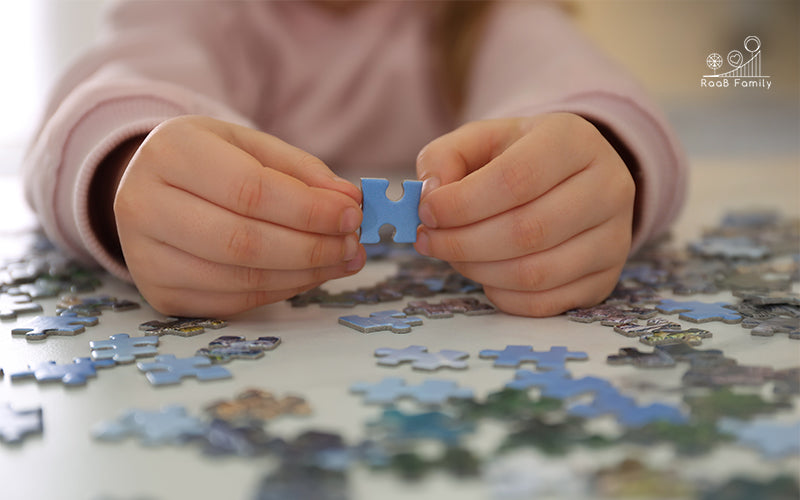
Solving jigsaw puzzles requires children to understand how different pieces fit together. And as they figure it out, they stimulate critical thinking and problem-solving skills. Manipulating puzzle pieces also helps refine fine motor skills, improving hand-eye coordination and precision.
-
Memory Games
Matching card games, where children flip cards to find pairs, enhance memory and concentration. It also involves visual discrimination, which trains children to recognise patterns and details.
-
Building and Construction
Building structures with blocks allows children to unleash their creativity as they imagine and build various designs. This process also promotes spatial reasoning and geometric understanding.
-
Pretend Play
Pretend play, involving dolls, action figures, or puppets, allows children to use their imagination to create stories and scenarios. As they interact with others, they also develop social skills such as cooperation, communication, and empathy.
-
Sorting and Classifying
Sorting objects by colour, size, shape, or category helps children develop classification skills, which are essential for organising information. This also fosters logical thinking and lays the groundwork for more advanced cognitive skills.
3.3. Parent-Child Interactive Play
Engaging in play times with your child doesn’t just strengthen bonds, but also contributes greatly to your child’s emotional development. Here are some activities you can consider participating in with your little one.
-
Read Together

Bedtime stories aren’t just scenes you’ll see in movies. Reading with your child, whether during the day or before sleep, is a magical way to connect with them and enhance their language skills. Allow them to choose their favourite stories and use different voices when you’re reading. During the process, throw in some open-ended questions about the plot and characters to encourage them to verbalise their thoughts on the story. This will foster thoughtful conversations, which are helpful in developing stronger linguistic abilities and familial bonds.
-
Musical Play
Listening to music is always fun, and singing or playing instruments together with your child can be great ways to boost their development. For example, their coordination, motor skills, and sensory perception.
-
Role-Playing
Imaginative play has always been a key aspect of childhood development. Engaging in role-playing scenarios with your child, such as having them act as a doctor while you pretend to be sick, allows them to express their creativity and activate their imaginative mind. Take turns assigning roles and building storylines together. Through role-playing, you can gain insights into your child's thoughts and emotions, and create a safe space for open communication.
-
Outdoor Adventures

Take the interactive play outdoors and explore the world together. Whether it's a nature walk, a visit to the park, or a day at the beach, outdoor activities provide endless opportunities for bonding. From simple games like catching and hide and seek to more complex ones like scavenger hunts, engaging in physical activities not only promotes a healthy lifestyle but also strengthens the parent-child connection through shared experiences and adventures.
-
Artistic Expression
Tips for Effective Parent-Child Bonding
- When engaging in activities with your child, resist the urge to rush through them. Instead, focus on the present moment and offer your undivided attention. This creates a deeper connection and allows for a more meaningful bonding experience.
- Empower your child with a sense of autonomy by letting them take the lead in choosing activities. You’ll develop their decision-making skills this way while also showing them that their preferences and opinions are valued.
- Facilitate meaningful conversations by asking open-ended questions that invite your child to share their thoughts and feelings. Actively listen without judgement to create an environment where they feel heard and understood.
- During play, take the time to acknowledge and celebrate your child's accomplishments, no matter how small. Offering genuine praise and encouragement to boost their confidence will reinforce a positive self-image.
- Approach activities with a positive and playful mindset to make play times enjoyable and relaxing so that your child will feel comfortable expressing themselves.
- Embrace the learning process by being patient during playtime. Allow your child the time and space to explore and discover the new things around them.
Frequently Asked Questions About Children’s Playtime
1. How much playtime do children need each day?
2. What are the benefits of playtime for children?
3. How to create a safe play area at home?
4. What types of toys are suitable for different age groups?
Toddlers: Building blocks and simple puzzles.
Preschoolers: Pretend play items and art supplies.
5. How to encourage imaginative play?
6. Should screen time be included in playtime?
7. How to balance structured and unstructured playtime?
8. How to involve parents in children's playtime?
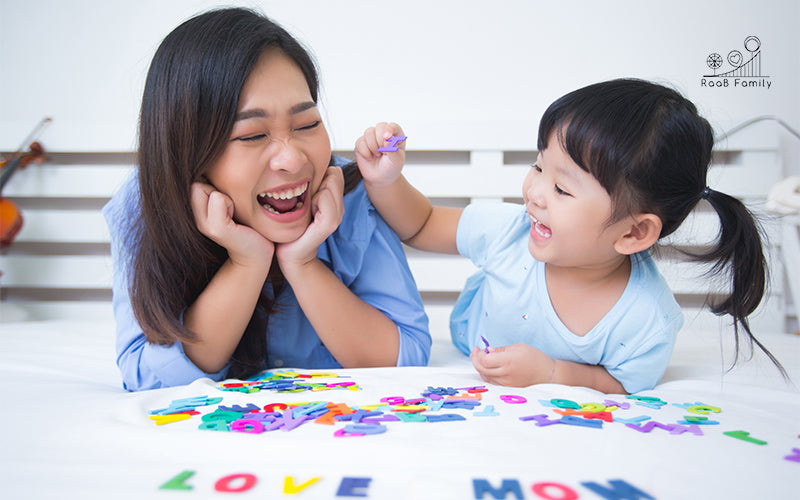
We cannot emphasise enough the importance of playtime, and we hope that this guide has helped you understand why fun activities are crucial for your child’s growth. If you’re keen on creating the nurturing environment your child deserves, we have all the equipment you need.
Build a safe and stimulating play space for your child today with RaaB Family, a baby store in Singapore that offers a collection of high-quality baby essentials and furniture, such as kids playhouse, baby floor mats, and more. Shop our range here!

